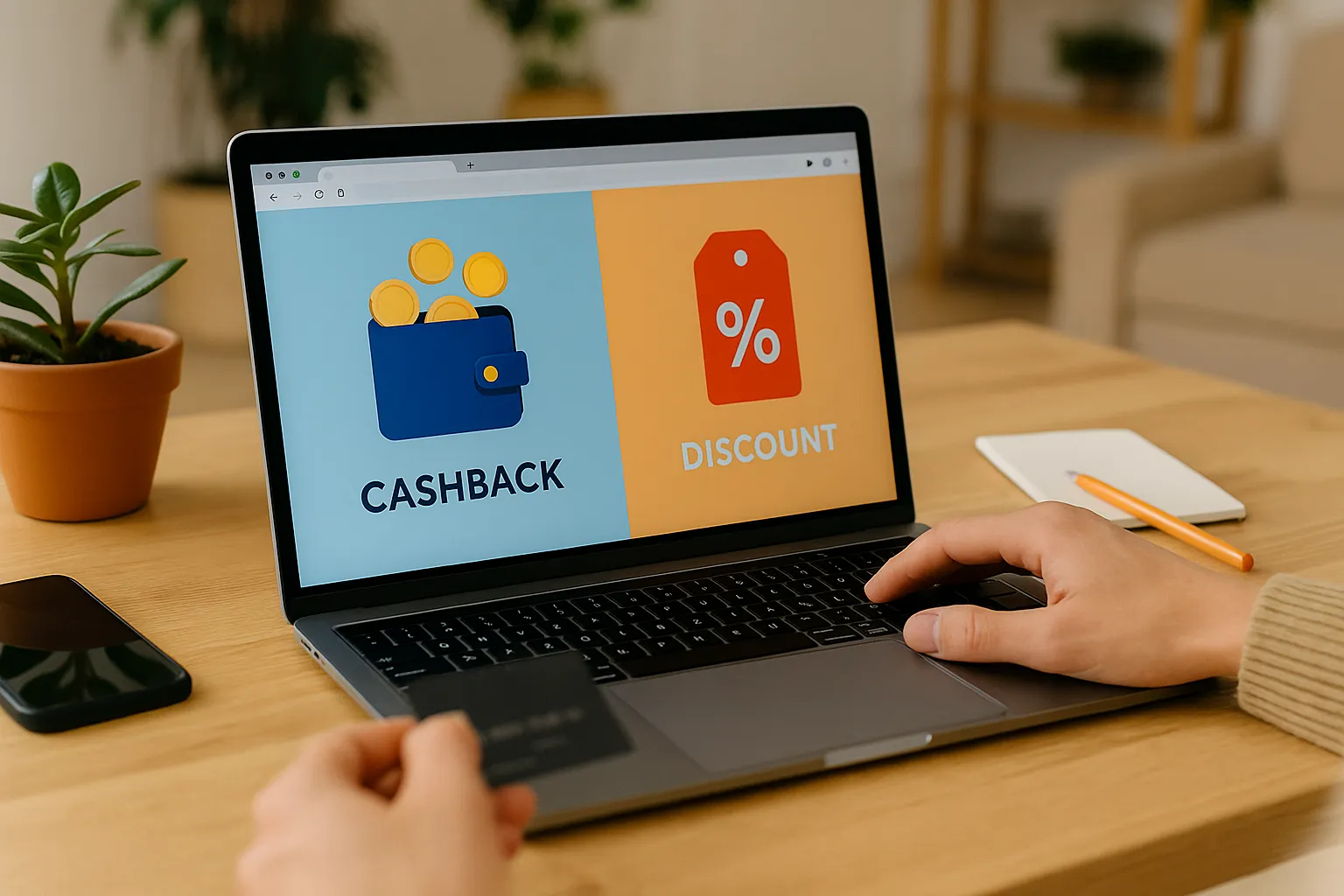Most shoppers choose savings offers based on habit, not value.
You see a cashback vs discounts option and go with what feels right. But that decision could be costing you more money over time.
Both strategies promise to help you save, but they do it in different ways. Discounts reduce the price before you pay, giving you less to part with at checkout. Cashback returns some money later if you follow through.
Neither is wrong, but each affects how you purchase, plan, and spend.
If you’re serious about saving money, you need more than a gut feeling. You need to understand how these options work and when to use them.
This guide breaks it down clearly, with examples and practical advice.
Curious what’s really saving you more? Read on to find out.
Cashback vs Discounts: How They Work
Cashback and discounts both aim to help you keep more of your money, but they work differently.
Cashback gives you a portion of your spending back after a purchase. This might come through a card provider, an app, or a store-specific program. It often feels like a bonus, but it requires action. You usually need to register for a program, activate an offer, or track the return.
In some cases, the amount is paid directly into your account or offered as a gift card or rebate.

In contrast, discounts reduce the price before you pay. They’re easy to spot, available at checkout, and require no follow-up. What you see is what you pay, which makes them appealing when you’re shopping quickly.
Here’s a quick breakdown:
| Feature | Cashback | Discounts |
| When you get savings | Later, as a rebate or return | Immediately at checkout |
| Best used for | Big purchases or planned buys | Everyday items or impulse buys |
| Risk of forgetting | High unless automated | Low |
| Follow-up required | Often yes | No |
| Control over savings | Moderate | High |
Each cashback offer or discount comes with its own rules. Knowing the differences helps you choose the better option before you spend your money.
Next, let’s look at when one works better than the other.
Saving Money Depends on the Context
Saving money isn’t always about choosing one method over the other. It depends on what you’re buying, how often, and how you manage your spending.
Discounts tend to work best for day-to-day purchases. If you’re shopping for groceries, school supplies, or toiletries, getting a lower price right at checkout keeps things simple. It helps with budgeting across the week and makes it easier to manage regular expenses.
Cashback can be a better choice when you’re making bigger, planned purchases. Electronics, holiday bookings, or yearly subscriptions often offer stronger cashback returns. If you can wait for the payout and you’re tracking your rewards, the savings add up.
Here’s an example. If you buy a $30 grocery bundle, a $5 discount is a welcome drop in your total. But if you’re booking a $1,000 flight, a 5% cashback means $50 back, worth the effort if you follow through.
It also depends on the habits of the customers. Some people check their accounts weekly and make use of every cashback. Others prefer the reliability of discounts that show up on the receipt.
If your goal is to stay in control of your shopping, know when each option makes sense. One helps right away. The other pays off later.
Now that we’ve looked at how context changes the value, let’s talk about what it really means to save.
The Best Way to Save Money
Some people think saving happens the moment they spot a deal. But real saving depends on what happens next. Did the money stay in your account, or did it slip away with the next purchase?
In this section, we’ll break down how to make your savings stick.
What Saving Actually Looks Like
Saving means keeping what you didn’t pay, not moving the money to something else. If you spend less at the checkout but swipe that leftover $10 on snacks, the savings disappear. A real result is when the unspent amount goes toward your financial goals, like a savings account or next week’s budget.
Why Cashback Needs a Plan
Cashback sounds like a win, but it often gets ignored. Many customers enjoy the idea of a reward, but without a plan, that money blends back into more spending. If your app gives you $8 back, move it straight into savings or use it to pay off a bill. Waiting too long makes it easy to forget.

When Discounts Work Best
Discounts feel helpful because they reduce what you pay upfront. But they only work when applied to planned purchases. If you grab something just because it’s marked down, it still chips away at your budget. Use discounts to lower costs on things already on your list.
How to Actually Save Money
Set a process. Move the leftover funds, even small ones, into a place where they can grow. A simple habit like this helps reduce spending, pay off debt, and build real savings over time.
Let’s now see how to connect this habit to a savings account you can grow.
Think Like a Saver: Link It to a Savings Account
Every time you reduce what you pay using cashback or a discount, you’re being given a chance to grow your savings. The problem is, most people don’t treat it that way.
Start thinking of these savings as money you can move. If you get $10 back through a cashback app or spend $12 less thanks to a coupon, don’t let it vanish into everyday spending. Transfer that amount to your savings account. This shift turns short-term deals into long-term value.
Some customers automate this using banking tools. When a cashback payment lands or a regular expense costs less than expected, they schedule a direct deposit or use a round-up feature to save the difference. This makes it easier to stay consistent without extra effort.
Many shopping rewards programs also let you receive cashback as a deposit. Instead of using those funds for more shopping, transfer them and build your savings.
Saving should be small, frequent, and automatic. Even a few dollars each week can add up if you stick with it.
Align with Your Long-Term Goals
Saving works best when it supports a clear purpose. That could be reducing debt, building a travel fund, or giving your monthly budget some breathing room. The way you save should match those goals.
Here’s how it breaks down:
- If your goal is to manage everyday spending, go with discounts.
They lower prices instantly, which helps you stretch your income and stay within budget. - If you’re working toward long-term goals, choose cashback.
It adds up over time, especially when you plan ahead and use apps or tools to track it. - If you need structure, set a monthly transfer.
Pro Tip: Move your cashback into a savings account automatically, so you don’t have to think about it.
For example:
- $20 in monthly cashback becomes $240 in a year
- Add weekly discounts, and your yearly savings stack up even more
The point is to use simple steps. Track your progress, stick to your plan, and let the right method support your bigger picture.

Choose Smart, Spend Smarter
Saving works best when it fits into your life. Both cashback and discounts can help you save, but they only pay off when you use them with intention.
Some customers rely on quick price drops to stay on budget. Others use cashback tools to build savings slowly. Each strategy has its place, depending on what you need and how you shop.
Start by watching your habits. Choose what supports your goals. Then build a simple routine that helps you keep more of your money.
To make that easier, use a tool designed to help. Unsubscribe Deals finds the best available discounts and cashback opportunities, all in one place.
You’ve got the insight. Now turn it into action.
